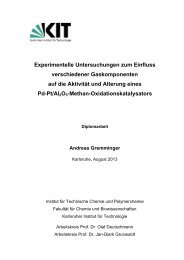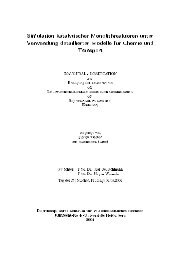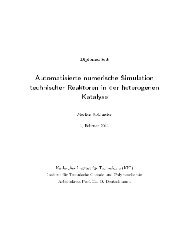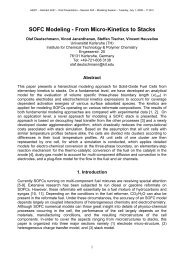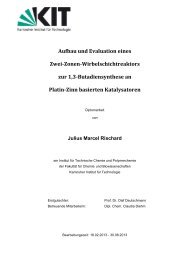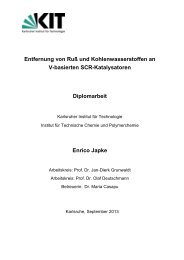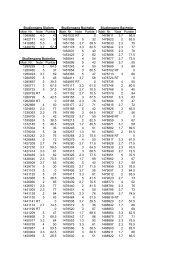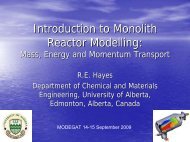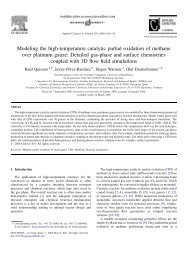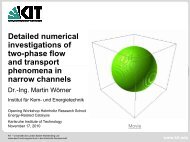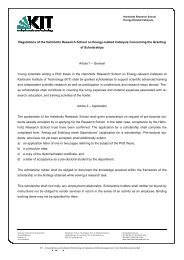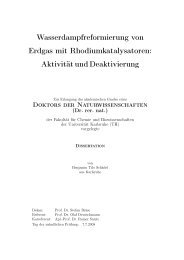Fuel Processing for Fuel Cells - Institut für Technische Chemie und ...
Fuel Processing for Fuel Cells - Institut für Technische Chemie und ...
Fuel Processing for Fuel Cells - Institut für Technische Chemie und ...
Create successful ePaper yourself
Turn your PDF publications into a flip-book with our unique Google optimized e-Paper software.
Author's personal copy<br />
22 Torsten Kaltschmitt and Olaf Deutschmann<br />
The combination of SR and POX is called ATR:<br />
<br />
C x H y O z þ nO 2 ðx<br />
zÞþH 2 O ! xCO 2 þ x z þ y <br />
H 2 ; DH 0 298 0: (15)<br />
2<br />
In reality, the reactions proceed via a complex network of elementary<br />
reactions and are often both in the gas phase and on the catalyst. Indeed,<br />
most of the fuel processing devices use heterogeneous catalysis, that is,<br />
the chemical conversion is carried out on the surface of a solid material,<br />
the catalyst. However, since most re<strong>for</strong>ming processes are conducted at<br />
temperatures above 400 C and sometimes even above 1000 C (POX,<br />
ATR), homogeneous conversion in the gas phase can accompany the<br />
catalytic conversion. The potential products of gas-phase reactions may<br />
be quite different from the ones obtained over the catalyst. The <strong>for</strong>mation<br />
of methane and light olefins are of particular interest. The latter ones may<br />
<strong>und</strong>ergo molecular growth processes leading to polyaromatic hydrocarbons<br />
(PAHs) and finally to soot particles and coke layers on the catalysts<br />
and the solid walls of the apparatus and pipes (Kaltschmitt et al., 2011).<br />
SR is the highly endothermic conversion of any hydrocarbon species<br />
by steam into a mixture of carbon monoxide and hydrogen, the synthesis<br />
gas. The product stream usually also contains unconverted steam and<br />
some fuel and carbon dioxide, the latter due to consecutive WGS. Even<br />
though SR requires the supply of steam and heat, it has been the primary<br />
route <strong>for</strong> the production of hydrogen and synthesis gas. A major advantage<br />
of SR in comparison to POX and ATR is the fact that no oxygen is<br />
needed, and there<strong>for</strong>e nitrogen does not need to be pumped through the<br />
process in case oxygen is provided in <strong>for</strong>m of air.<br />
POX offers a possibility to run the fuel processor without additional<br />
devices <strong>for</strong> providing heat and steam; aside from the fuel, only oxygen<br />
(air) is needed. Using noble metal catalysts such as rhodium—this process<br />
is called CPOX—the fuel can be converted within milliseconds. By recycling<br />
the steam containing exhaust gas of the fuel cell stack, the CPOX<br />
re<strong>for</strong>mer could be operated as an ATR re<strong>for</strong>mer. For start-up, the C/O<br />
ratio may be decreased (C/O



